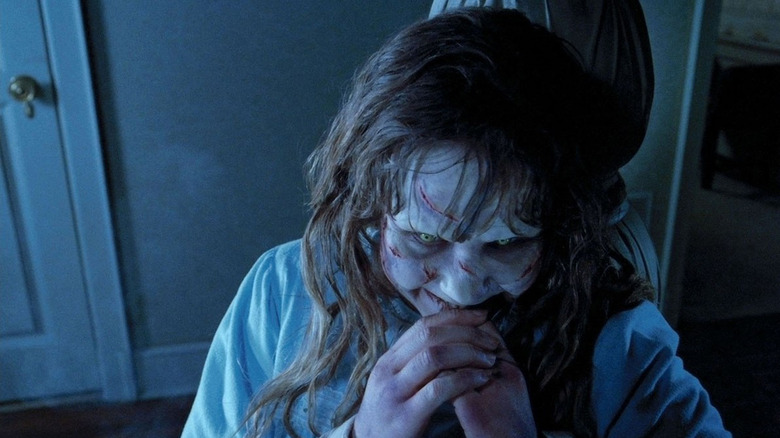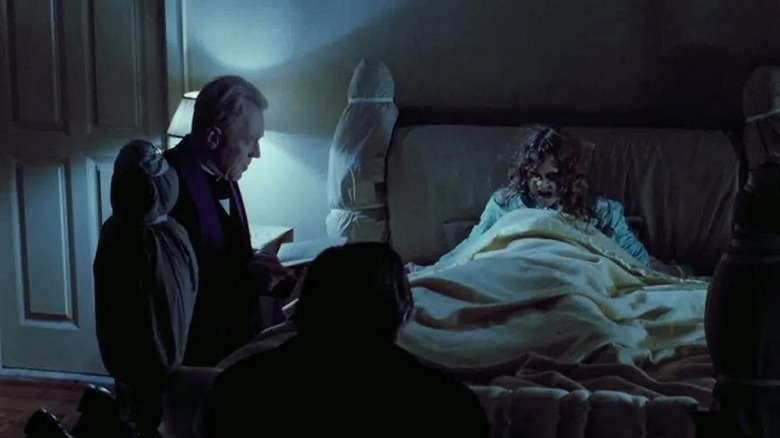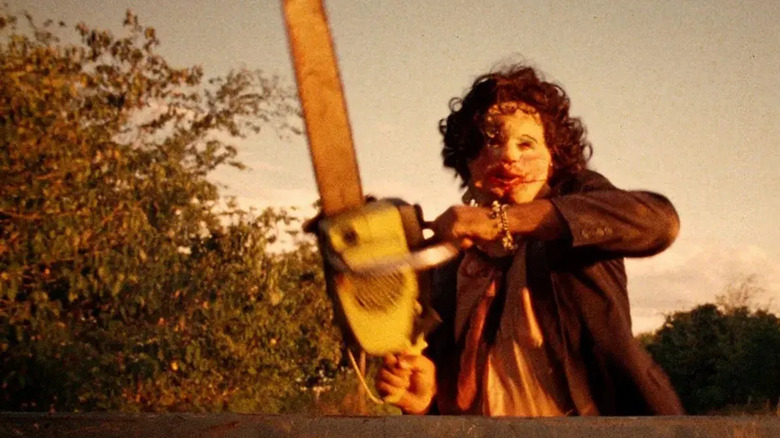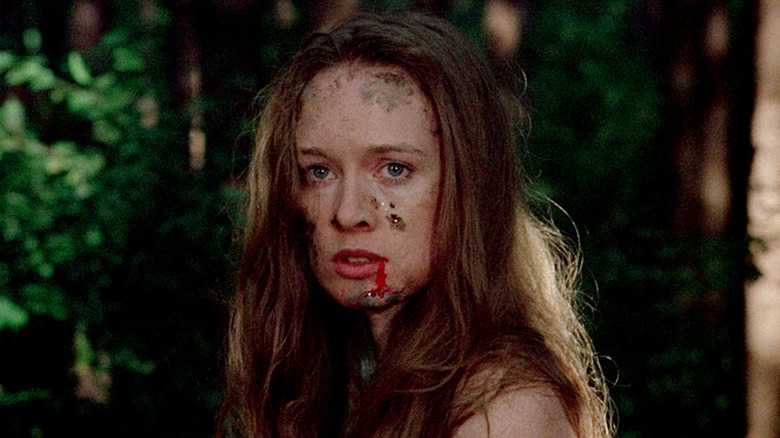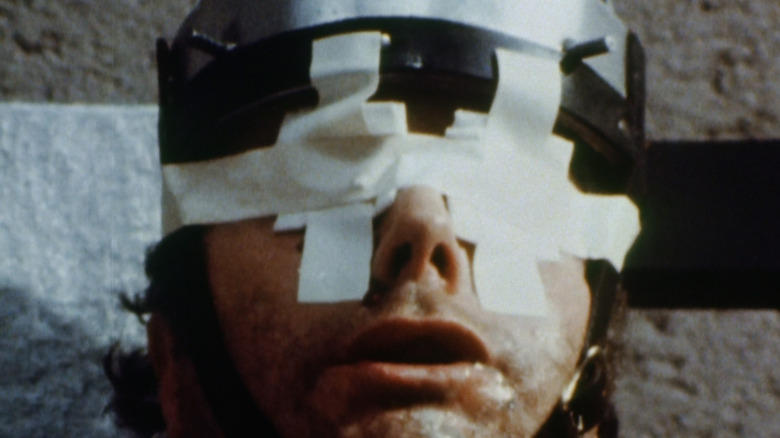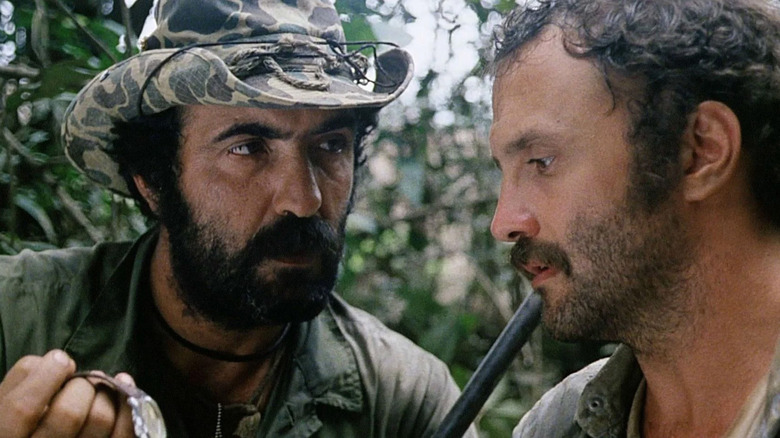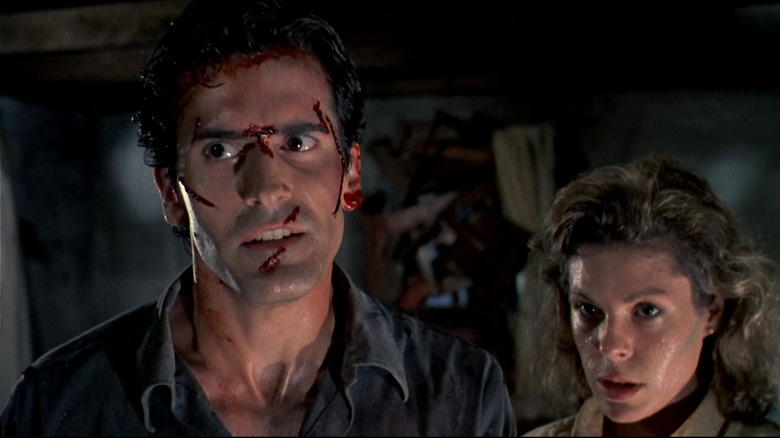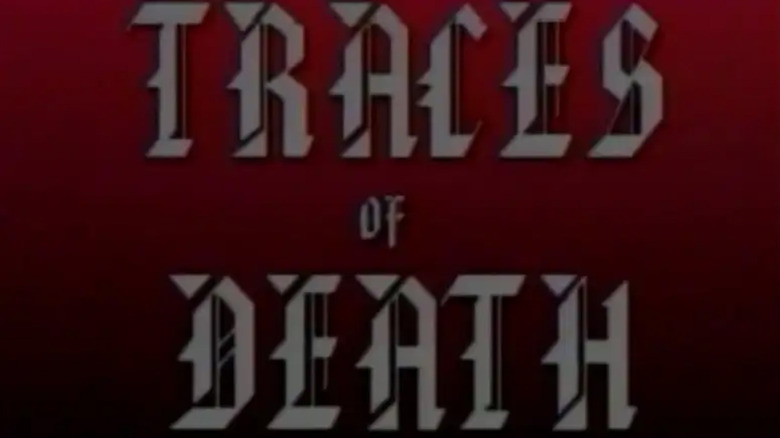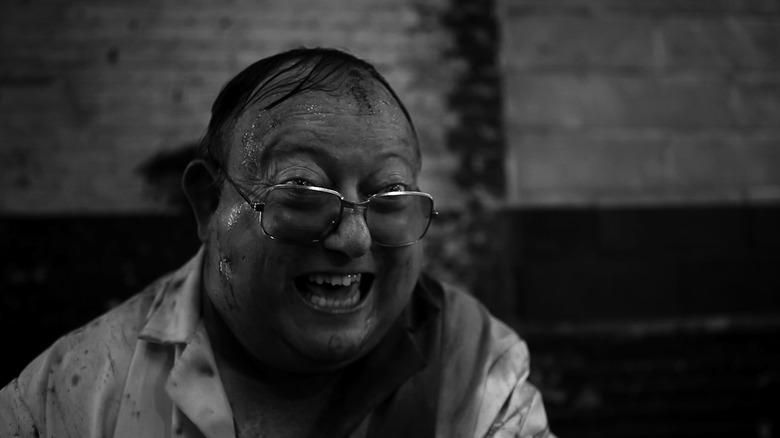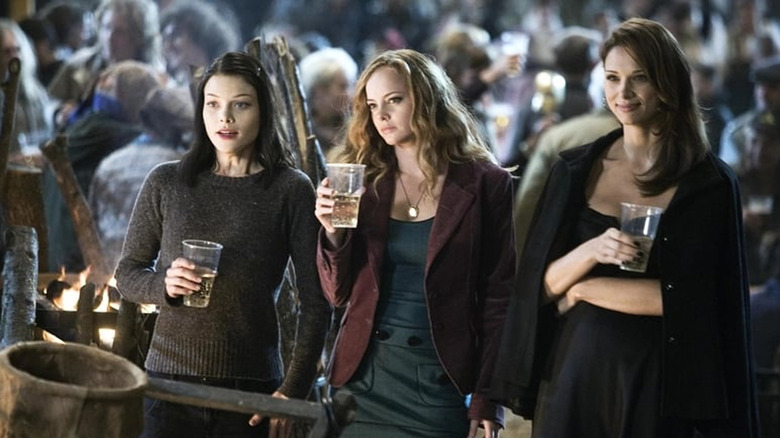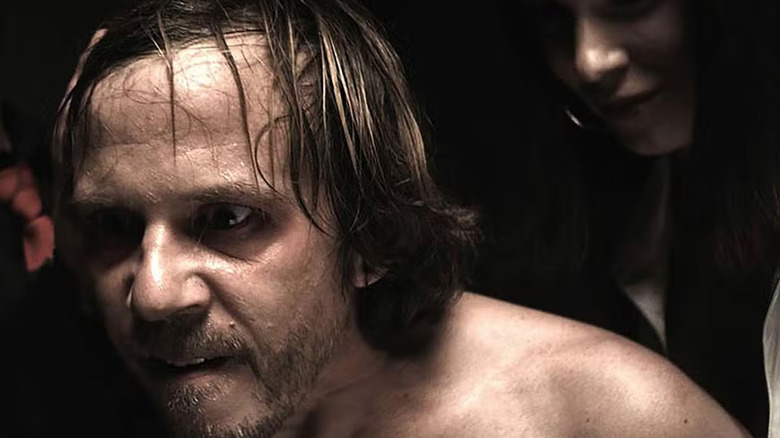10 Banned Horror Movies That Found A Home In The US
It's been a long time since the video nasties of the '80s gave pause to U.K. censors. Nevertheless, horror movies remain one of the most banned film genres across the globe. Whether it's the leather-faced antics of "The Texas Chainsaw Massacre" or the gross-out horror of "The Human Centipede," governments and censors across the world still blame the corruption of youth on these cinematic horrors.
But American censors tend to be a bit more lenient.
The land of the free is certainly a fitting home for some of horror's most divisive movies, and it's not surprising to find that many of the most banned films are still available in the U.S. Even the once-banned horror flick "Cannibal Holocaust" eventually found itself available once more after being banned for five years after its release in 1980.
How does a film get banned? Well, there are lots of different ways that a movie can find itself under the wrath of the censors, or the rare occasion when screening a movie could be considered criminal. There are even times when a film might be pulled by a cinema chain, with U.K's Cineworld canceling screenings of the recent horror flick, "Dashcam".
Although some countries have stricter rules and regulations than others, the U.S. is often a safe haven for films deemed too extreme ... and that means many of the banned films from across the globe manage to avoid the censors on American soil.
Here are 10 of the most noteworthy banned horror movies that were released in the United States.
The Exorcist (1973)
One of the most high-profile banned films of all time, "The Exorcist" became notorious after it received an outright ban in numerous countries.
Telling the story of the exorcism of Regan MacNeill (Linda Blair) — a young girl who becomes possessed by the spirit of a demon. The film chronicles attempts to rid the girl of this demon by an exorcist and his colleague, played by Jason Miller and Max Von Sydow.
From the moment of the film's theatrical release, "The Exorcist" saw severe pushback in the U.K. Members of the clergy protested its release, and after a successful VHS release in 1981, it became effectively banned in 1984 when the BBFC refused the film a certificate under the Video Recordings Act 1984. The film remained unavailable to buy in the U.K. until 1999.
Of course, "The Exorcist" didn't face these restrictions in the U.S.
Although many critics felt the film should have been X rated, the MPAA awarded the film an R rating, much to the studio's delight. An R rating meant a much wider audience, with X ratings usually given to pornographic films, ensuring children are not allowed to watch them under any circumstances.
And so, despite the U.K. ban, "The Exorcist" went on to huge success, becoming the highest-grossing R-rated movie ever until "It" took the top spot in 2017. "The Exorcist" may have been notorious, but it was a thoroughly gripping horror, with U.S. fans ensuring that the film still had a huge audience.
The Texas Chain Saw Massacre (1974)
One of the most controversial horror movies of all time, "The Texas Chain Saw Massacre" was a revolutionary step up for cinematic violence. Released in 1974, it was one of the first films credited with creating elements of the slasher genre... and was banned in several countries.
One of the most well-known video nasties, "The Texas Chain Saw Massacre" became synonymous with the whole idea of banned movies. And for good reason — it was banned in the U.K. for a total of 25 years from its initial release in 1974 until 1999.
"The Texas Chain Saw Massacre" was banned on the advice of The British Board of Film Classification (BBFC) and even copycats could not use the word "chainsaw" in subsequent movies. But by 1999 the BBFC reclassified the film, allowing it to be released with an 18 certificate.
But it's not just the British who didn't like "The Texas Chain Saw Massacre."
It was initially refused a rating in Australia and remained banned until it was eventually given an R rating in 1984. Elsewhere, the film was banned at various points across Brazil, Chile, Finland, France, Iceland, Ireland, Norway, Singapore, Sweden, and West Germany.
Although some theaters saw audiences walk out of "The Texas Chain Saw Massacre" in disgust, the film enjoyed a wide release in the U.S. going on to huge success. There was even a recent sequel.
I Spit On Your Grave (1978)
A brutal rape-revenge horror from director Meir Zarchi, "I Spit On Your Grave" was always going to come under scrutiny from the censors. Starring Camille Keaton as Jennifer Hills, the film follows the horrific story of Jennifer's sexual assault ... and the revenge she enacts upon her tormentors.
"I Spit On Your Grave" was met with almost entirely negative reviews, with famed critic Roger Ebert describing it as "a vile bag of garbage...without a shred of artistic distinction".
Worse yet, the film was banned across the globe. Ireland, Norway, Iceland, and West Germany banned "I Spit On Your Grave" outright, and while Canada initially banned the film, it later allowed individual provinces to make their own decisions on the movie in the 1990s.
The United Kingdom refused the film a certificate, forcing "I Spit On Your Grave" straight to home video since this was unregulated at the time. Soon enough, the film was added to a "banned" list of prosecutable films and remained banned until 2001.
Even in the U.S. "I Spit On Your Grave" was surrounded by controversy. Although the film was initially given an R rating, producers attempted to add in further graphic scenes of rape and violence once the rating had been secured. The MPAA took the film's producers to court, claiming that the additional scenes would bump the film up to an X rating.
The film was eventually released without a distributor in a handful of theaters across the U.S., giving the film a reluctant home on American soil before its eventual re-release in 1980. But while "I Spit On Your Grave" may not have ignited the box office, it's since become one of the most well-known banned movies of all time.
Faces of Death (1978)
There are some films that live in infamy – "Faces of Death" is one of them. Released in 1978, the mondo horror directed by John Alan Schwartz has been the subject of myth and legend. It's the film you were warned about as a kid ... and it's as bad as you've been told.
"Faces of Death" follows pathologist Francis B. Gröss (Michael Carr) exploring the many different, and gruesome, ways you can die. It's a simple concept that went a bit too far, with staged or fake deaths cut between footage of very real, actual death scenes. Makeup artist Allan A. Apone estimated that around 60% of the film used real footage of actual death scenes, with clips of extreme fatal accidents and surgical mishaps accounting for some of that. Even more controversially, graphic scenes from the crash of Flight 182 were added. The infamous air crash occurred just weeks before the film's release, making these segments both horrific to watch and incredibly insensitive — a double whammy that makes you wonder how this got made in the first place.
Although "Faces of Death" was often said to be banned in 40-plus countries, that's not exactly true. However, the film was banned outright in New Zealand, in Australia until 2007, and in the U.K. until a revised cut was approved for DVD in 2003 — removing two minutes and 13 seconds of footage. Despite this, the film was a huge hit at the U.S. box office.
"Face of Death" earned a whopping $35 million on a budget of just $450,000. But while audiences went mad for its real-life scenes, critics weren't so fussed. Steve Crum denounced the film as "crude, tasteless exploitation footage. Filmed carnage." And it's hard to argue with that. But U.S. audiences loved it anyway.
Cannibal Holocaust (1980)
One of the first found-footage horror films, "Cannibal Holocaust" is as notorious as it is legendary. Including depictions of cannibalism and very real on-screen animal deaths, the film was presented as a real-life documentary, charting the gruesome voyage of anthropologist Harold Monroe (Robert Kirkman) who leads a rescue mission into the Amazon rainforest to look for a crew of filmmakers.It's gruesome and thoroughly upsetting ... and was so realistic that director Ruggero Deodato was arrested for murder upon the film's release. Really.
The controversy began when a French magazine suggested that "Cannibal Holocaust" was actually a snuff film, with several death scenes presumed to be too realistic otherwise. Italian magistrates, who already hit Deodato with obscenity charges, then amended them to include murder. Questions were asked about the lack of media appearances of the supposedly deceased actors, who it turns out, had signed a contract not to make any media appearances for one year after the film's release, all in an effort to make the fake documentary seem more real.
Luckily, an appearance from the "dead" actors convinced the courts that Deodato was not actually a murderer... but the film had already earned its place among the most notorious horror movies of all time.
"Cannibal Holocaust" was banned outright in Australia, Norway, Finland, Iceland, New Zealand, and Singapore, and while the U.K. released the film straight-to-VHS, it was eventually banned as part of the U.K. governments video nasties list. Nevertheless, the film found a home in the U.S.Originally banned across the States, it was eventually released unrated in 1985 and even made its way to DVD and Blu-ray. But it remains one of the most controversial horror movies of all time.
The Evil Dead (1981)
It's almost laughable by today's standards, but yes, "The Evil Dead" was originally banned. Sam Raimi's quintessential cabin-in-the-woods story, the film is a campy schlock-fest, full to the brim with over-the-top acting and sill special effects. It's a joyous horror-filled romp in an era when this was about as scary as you can imagine ... even if it is a bit cheesy.
But yes, "The Evil Dead" was too much for some.
The film follows Ash Williams (Bruce Campbell) and his gang of pals as a trip to a lone cabin in the woods swiftly goes sideways when they inadvertently summon a demon. Everything about the film was campy in the best way possible, but its effects earned it a place among the most notorious splatter films of its day.
In the United Kingdom, it was given an X rating but was released unrated on VHS. However, the appearance of the Video Recordings Act in 1984 saw VHS copies of "The Evil Dead" removed from circulation. In 1990, an edited version was granted an 18-rating, and it wasn't until 2000 that the uncut version was rated 18, effectively unbanning it. The film remains banned to this day in several countries.
However, the U.S. gave Raimi's horror hit a much easier time. Originally given an X rating, "The Evil Dead" was still given a theatrical release and was eventually reclassified as NC-17 for "substantial graphic horror violence and gore." Groovy.
Traces of Death (1993)
Does a feature-length clip show of real crime scene footage and medical photos qualify as a film? "Traces of Death" pushes the boundaries of both art and decency with its shocking depictions of real deaths and violence. Seriously, this film is disturbingly abhorrent. Some "highlights" include:
- The 1980 Iranian Embassy siege.
- The 1966 motorcycle stunt accident of Evel Knievel.
- The 1990 parachute skydiving accident of Mike Mcgee and Greg Jones.
- The 1987 press conference suicide of R. Budd Dwyer.
The footage used throughout "Traces of Death" is not faked or staged — it is 100% real crime scene footage and medical examiner images, assembled as a sort-of shockumentary with a voiceover from Damon Fox. It's effectively a kind of snuff film, created in response to "Faces of Death." Which asks the question, "why does this exist?"
The censors seem to agree.
The United Kingdom outright banned the film, refusing its classification, stating the film has "no journalistic, educational or other justifying context for the images shown." The BBFC also suggests that it could breach U.K. law under the Obscene Publications Act. Meanwhile, the entire series of "Traces of Death" movies are frequently confiscated by Australian customs authorities. According to Australian regulations, the films "offend against the standards of morality, decency, and propriety generally accepted by reasonable adults to the extent that they should not be imported."
"Traces of Death" remains unrated in the U.S. but nevertheless found a cult following via its straight-to-video distribution. It's the kind of VHS gore hounds would exchange in the back rooms of video stores in the '90s ... and it sadly hasn't been left there.
The Human Centipede 2: Full Sequence (2011)
It's safe to say that "The Human Centipede" has earned plenty of notoriety since its release. The concept is thoroughly disgusting to say the least, as a mad scientist (Dieter Laser) joins three human victims together end to end, creating a "human centipede." Yes, it's horrible, but the use of bandages allowed much of the grotesque body horror to remain implied.
Not so in its sequel, "The Human Centipede 2 (Full Sequence)." Here, director Tom Six cranks up the gross-out horror to 11 with homemade surgical tools, a 10-person centipede, and some frankly disturbing images that leave very little to the imagination. We're treated to scenes of extreme sexual violence, an infant death, and even a scene of explosive diarrhea, which given the context, is even worse than it might usually be.
"The Human Centipede 2" was so gross that it was initially refused classification in the U.K. even with the BBFC's more modern, relaxed rulings. Considered "too obscene" to be released, it was thought that "no amount of cuts" would make the film suitable for release. Ultimately, the BBFC changed its mind. After 32 cuts, removing two minutes and 37 seconds of footage, the movie was granted an 18 rating. The film is still banned in New Zealand.
However, in the U.S. the film found its audience. "The Human Centipede 2" debuted at Fantastic Fest in 2011 where viewers were handed complimentary "barf bags" with an ambulance stationed outside the screening as a gimmick. Remaining unrated, the film was given a limited release across the country, with midnight showings at just 24 theaters.
"The Human Centipede 2" may have only grossed $140,000 but the film found its audience on DVD and Blu-ray, becoming a hit among certain fans of exploitation and body horror.
Hostel Part II (2007)
It's no secret that "Hostel" defined the so-called "torture porn" subgenre – a combination of splatter and slasher movies that rose to prominence in the 2000s. But "Hostel Part II" is considered even more obscene than the original movie, and for good reason.
Although both films tell the story of an underground organization that tortures and kills captured tourists, the sequel doesn't exactly hold back on the gore. "Hostel Part II" follows three female art students who become caught up with the Elite Hunting Club, pursued as potential victims for the organization's wealthy members. And this time around, we're treated to scenes depicting genital mutilation, cannibalism, and scalping. Yum.
"Hostel" was originally banned in Ukraine with Slovakian officials renouncing (but not banning) it.
The sequel, however, was banned outright in New Zealand, and was even brought up in the House of Commons in the U.K. as members of parliament discussed a proposed law to criminalize possession of "extreme pornography." One MP posited that owning still from "Hostel Part II" could violate this new law, despite the fact that he had never actually seen the film. In Germany, the film was cut to secure a theatrical release, but the later "extended cut" was banned outright. In fact, a Munich court found the release of this new, "extended cut" to be punishable by law.
Unsurprisingly, the U.S. gave the film an R rating, securing a wide release for the film. But despite plenty of media coverage and controversy, "Hostel Part II" grossed just $35 million — far less than its predecessor. But still a win for a banned movie.
A Serbian Film (2010)
One of the nastiest, most horrific films ever made, "A Serbian Film" deserve its notoriety. The story of a former adult film star (Srđan Todorović) who is manipulated into starring in an increasingly sadistic art film, "A Serbian Film" has gained a reputation for being one of the most extreme horror movies ever made. It's not for the faint-hearted, with depictions of necrophilia, pedophilia, and some of the most horrific moments ever captured on film. Scenes include the rape and murder of a newborn infant, sex with cadavers, and a finale that sees the drugged protagonist have sex with his own child.
It's just about the sickest film you can imagine, and even the subtext about the Serbian government's control of its people isn't enough to give "A Serbian Film" even a glimmer of redemption.
Unsurprisingly, the censors went wild for this one.
"A Serbian Film" has been banned in Germany, Norway, Brazil, Australia, New Zealand, Malaysia, Spain, and Singapore. Even countries that passed the film for theatrical viewing required extensive cuts and amendments to make the film remotely suitable. Surprisingly, the U.K. was among those who allowed the film, following censorship and cuts.
The United States provided, once again, a home for the movie, and with some cuts, "A Serbian Film" even managed to land an NC-17 rating. That's absolutely wild. The uncut version remains unrated. It may have been released fairly easily in the U.S. but honestly, would you really want to see it?
